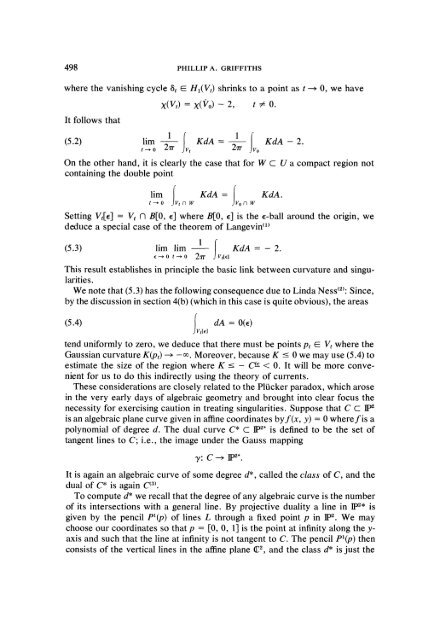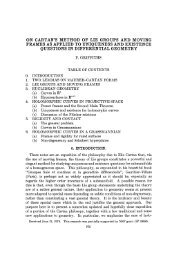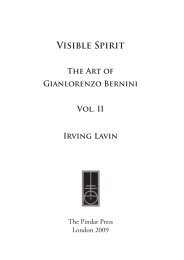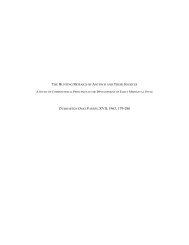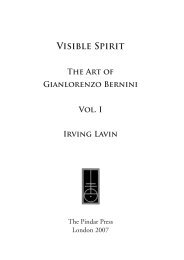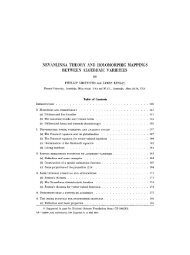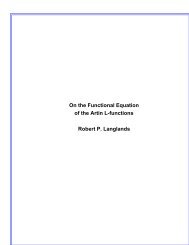View PDF - Project Euclid
View PDF - Project Euclid
View PDF - Project Euclid
You also want an ePaper? Increase the reach of your titles
YUMPU automatically turns print PDFs into web optimized ePapers that Google loves.
498 PHILLIP A. GRIFFITHS<br />
where the vanishing cycle 8t Hl(Wt) shrinks to a point as O, we have<br />
x(V,) X(Vo) 2, t o.<br />
It follows that<br />
(5.2) lim KdA<br />
t-0 2zr<br />
2rr<br />
Ir<br />
KdA 2.<br />
On the other hand, it is clearly the case that for W C U a compact region not<br />
containing the double point<br />
lim Iv KdA .fv<br />
t--* O W V W<br />
KdA<br />
Setting Vt[] Vt B[0, ] where B[0, ] is the e-ball around the origin, we<br />
deduce a special case of the theorem of Langevin (1<br />
(5.3) lira lira<br />
0 0 2r Jvt[l<br />
1 l KdA 2.<br />
This result establishes in principle the basic link between curvature and singularities.<br />
We note that (5.3) has the following consequence due to Linda Ness2: Since,<br />
by the discussion in section 4(b) (which in this case is quite obvious), the areas<br />
(5.4) dA 0()<br />
--<br />
jvt[]<br />
tend uniformly to zero, we deduce that there must be points p V where the<br />
Gaussian curvature K(pt) -o. Moreover, because K _< 0 we may use (5.4) to<br />
estimate the size of the region where K _< C < 0. It will be more convenient<br />
for us to do this indirectly using the theory of currents.<br />
These considerations are closely related to the HOcker paradox, which arose<br />
in the very early days of algebraic geometry and brought into clear focus the<br />
necessity for exercising caution in treating singularities. Suppose that C c IW<br />
is an algebraic plane curve given in affine coordinates byf(x, y) 0 wherefis a<br />
polynomial of degree d. The dual curve C* c IW* is defined to be the set of<br />
tangent lines to C; i.e., the image under the Gauss mapping<br />
C.<br />
T: C--> Ip2..<br />
It is again an algebraic curve of some degree d*, called the class of C, and the<br />
dual of C* is again<br />
To compute d* we recall that the degree of any algebraic curve is the number<br />
of its intersections with a general line. By projective duality a line in IW* is<br />
given by the pencil pl(p) of lines L through a fixed point p in IW. We may<br />
choose our coordinates so that p [0, 0, 1] is the point at infinity along the yaxis<br />
and such that the line at infinity is not tangent to C. The pencil P(p) then<br />
consists of the vertical lines in the affine plane 2, and the class d* is just the


